Comparison of Ozone Production Regimes between Two Mexican Cities: Guadalajara and Mexico City
Abstract
:1. Introduction
2. Geography and Climate
3. Field Data
4. Chemical Transport Simulation
4.1. Emissions Data
4.2. Simulation Model
4.3. Comparison with Field Data
4.3.1. Surface Data
4.3.2. Vertical Profiles of O3
4.4. Ozone Formation Regime
5. Conclusions
Acknowledgments
Author Contributions
Conflicts of Interest
Appendix A. Effect of Modifying the GMA Vehicle Fleet
| Modified Vehicle Types | VOC | NOx | α | β |
|---|---|---|---|---|
| LDGV | 15 | 12 | 0.85 | 0.88 |
| LDGV, Light-duty trucks | 29 | 15 | 0.71 | 0.85 |
| LDGV, Light-duty trucks, Heavy-duty trucks | 30 | 18 | 0.70 | 0.82 |
References
- Benítez-García, S.E.; Kanda, I.; Wakamatsu, S.; Okazaki, Y.; Kawano, M. Analysis of criteria air pollutant trends in three Mexican metropolitan areas. Atmosphere 2014, 5, 806–829. [Google Scholar] [CrossRef]
- Molina, L.T.; Madronich, J.S.; Gaffney, J.S.; Apel, E.; de Foy, B.; Fast, J.; Ferrare, R.; Herndon, S.; Jimenez, J.L.; Lamb, B.; et al. An overview of the MILAGRO 2006 Campaign: Mexico City emissions and their transport and transformation. Atmos. Chem. Phys. 2010, 10, 8697–8760. [Google Scholar] [CrossRef] [Green Version]
- Seinfeld, J.H.; Pandis, S.N. Atmospheric Chemistry and Physics: From Air Pollution to Climate Change; John Wiley & Sons: Hoboken, NJ, USA, 2006. [Google Scholar]
- Sillman, S.; Vautard, R.; Menut, L.; Kley, D. O3-NOx-VOC sensitivity and NOx-VOC indicators in Paris: Results from models and Atmospheric Pollution Over the Paris Area (ESQUIF) measurements. J. Geophys. Res. 2003, 108, 8563. [Google Scholar] [CrossRef]
- Kleinman, L.I.; Daum, P.H.; Lee, Y.-N.; Nunnermacker, L.J.; Springston, S.R.; Weinstein-Lloyd, J.; Rudolph, J. A comparative study of ozone production in five U.S. metropolitan areas. J. Geophys. Res. 2005, 110, D02301. [Google Scholar] [CrossRef]
- Sillman, S.; Al-Wali, K.I.; Marsik, F.J.; Nowacki, P.; Samson, P.J.; Rodgers, M.O.; Garland, L.J.; Martinez, J.E.; Stoneking, C.; Imhoff, R.; et al. Photochemistry of ozone formation in Atlanta, GA—Models and measurements. Atmos. Environ. 1995, 29, 3055–3066. [Google Scholar] [CrossRef]
- Ramírez-Sánchez, H.U.; Andrade-García, M.D.; Bejaran, R.; García Guadalupe, M.E.; Wallo Vázquez, A.; Pompa Toledano, A.C.; de la Torre Villaseñor, O. The spatial-temporal distribution of the atmospheric polluting agents during the period 2000–2005 in the urban area of Guadalajara, Jalisco, Mexico. J. Hazard. Mater. 2009, 165, 1128–1141. [Google Scholar] [CrossRef] [PubMed]
- Jaimes-Lopez, J.L.; Sandoval-Fernandez, J.; Gonzalez-Ortiz, E.; Vazquez-Garcia, M.; Gonzalez-Macias, U.; Zambrano-Garcia, A. Effect of liquefied petroleum gas on ozone formation in Guadalajara and Mexico City. J. Air Waste Manag. Assoc. 2005, 55, 841–846. [Google Scholar] [CrossRef] [PubMed]
- Mendoza, A.; Garcia, M.R. Application of a second-generation air quality model to the Guadalajara metropolitan area, Mexico. Rev. Int. Contam. Ambient. 2009, 25, 73–85. [Google Scholar]
- Harley, H.A.; Russel, A.G.; McRae, G.J.; Cass, G.R.; Seifeld, J.H. Photochemical modeling of the southern California air quality study. Environ. Sci. Technol. 1993, 27, 378–388. [Google Scholar] [CrossRef]
- Mendoza, A.; Garcia, M.R. Inverse modeling applied to the analysis of emission inventory of the metropolitan area of Guadalajara, Mexico. Rev. Int. Contam. Ambient. 2011, 27, 199–214. [Google Scholar]
- Escarela, G. Extreme value modeling for the analysis and prediction of time series of extreme tropospheric ozone levels: A case study. J. Air Waste Manag. Assoc. 2012, 62, 651–661. [Google Scholar] [CrossRef] [PubMed]
- García, I.; Marbán, A.; Tenorio, Y.M.; Rodriguez, J.G. Ozone concentration forecast in Guadalajara-Mexico using artificial neuronal networks. Inf. Tecnol. 2008, 19, 89–96. [Google Scholar]
- Byun, D.; Schere, K.L. Review of the governing equations, computational algorithms, and other components of the Models-3 Community Multiscale Air Quality (CMAQ) modeling system. Appl. Mech. Rev. 2006, 59, 51–77. [Google Scholar] [CrossRef]
- Whiteman, C.D.; Zhong, S.; Bian, X.; Fast, J.D.; Doran, J.C. Boundary layer evolution and regional-scale diurnal circulations over the Mexico Basin and Mexican plateau. J. Geophys. Res. 2000, 105, 10081–10102. [Google Scholar] [CrossRef]
- Kanda, I.; Basaldud, R.; Horikoshi, N.; Okazaki, Y.; Benítez-Garcia, S.E.; Ortínez, A.; Ramos Benítez, V.R.; Cárdenas, B.; Wakamatsu, S. Interference of sulphur dioxide on balloon-borne electrochemical concentration cell ozone sensors over the Mexico City metropolitan area. Asian J. Atmos. Environ. 2014, 8, 162–174. [Google Scholar] [CrossRef]
- Benítez-García, S.E.; Kanda, I.; Wakamatsu, S.; Okazaki, Y.; Kawano, M. Investigation of vertical profiles of meteorological parameters and ozone concentration in the Mexico City metropolitan area. Asian J. Atmos. Environ. 2015, 9, 114–127. [Google Scholar]
- Garzón, J.P.; Huertas, J.I.; Magaña, M.; Huertas, M.E.; Cárdenas, B.; Watanabe, T.; Maeda, T.; Wakamatsu, S. Volatile organic compounds in the atmosphere of Mexico City. Atmos. Environ. 2015, 119, 415–429. [Google Scholar] [CrossRef]
- Jaimes-Palomera, M.; Retama, A.; Elias-Castro, G.; Neria-Hernández, A.; Rivera-Hernández, O.; Velasco, E. Non-methane hydrocarbons in the atmosphere of Mexico City: Results of the 2012 ozone-season campaign. Atmos. Environ. 2016, 132, 258–275. [Google Scholar] [CrossRef]
- Komhyr, W.D.; Barnes, R.A.; Brothers, G.B.; Lathrop, J.A.; Opperman, D.P. Electrochemical concentration cell ozonesonde performance evaluation during STOIC 1989. J. Geophys. Res. 1995, 100, 9231–9244. [Google Scholar] [CrossRef]
- Instituto Nacional de Estadística y Geografía (INEGI). Available online: http://www.inegi.org.mx/geo/contenidos/recnat/usosuelo/ (accessed on 1 February 2016).
- OpenStreetMap. Available online: https://www.openstreetmap.org/ (accessed on 1 February 2016).
- Statistics Bureau, Japan Ministry of Internal Affairs and Communications. Basic Survey of Social life. 2006; (In Japanese). Available online: http://www.stat.go.jp/data/shakai/2006/gaiyou.htm (accessed on 1 February 2016). [Google Scholar]
- U.S. Environmental Protection Agency. Available online: http://www3.epa.gov/ttn/chief/emch/speciation/ (accessed on 1 February 2016).
- Carter, W.P.L. Development of an Improved Chemical Speciation Database for Processing Emissions of Volatile Organic Compounds for Air Quality Models. Available online: http://www.engr.ucr.edu/~carter/emitdb/ (accessed on 1 February 2016).
- Morikawa, T. Source speciation profiles VOC, PM, and NOx for PM2.5 regional air-quality simulations. In Japan Auto-Oil Program Technical Report; Japn Auto-Oil Program: Tokyo, Japan, 2012; JPEC-2011AQ-02-08. [Google Scholar]
- Skamarock, W.C.; Klemp, J.B.; Dudhia, J.; Gill, D.O.; Barker, D.M.; Duda, M.G.; Huang, X.-Y.; Wang, W.; Powers, J.G. A Description of the Advanced Research WRF; NCAR/TN-475+STR; NCAR UCAR OpenSky. Available online: http://nldr.library.ucar.edu/repository/collections/TECH-NOTE-000-000-000-855 (accessed on 15 July 2016).
- Guenther, A.B.; Jiang, X.; Heald, C.L.; Sakulyanontvittaya, T.; Duhl, T.; Emmons, L.K.; Wang, X. The Model of Emissions of Gases and Aerosols from Nature version 2.1 (MEGAN2.1): An extended and updated framework for modeling biogenic emissions. Geosci. Model Dev. 2012, 5, 1471–1492. [Google Scholar] [CrossRef] [Green Version]
- Willmott, C.J. On the validation of models. Phys. Geogr. 1981, 2, 184–194. [Google Scholar]
- Chang, J.C.; Hanna, S.R. Air quality model performance evaluation. Meteorol. Atmos. Phys. 2004, 87, 167–196. [Google Scholar] [CrossRef]
- National Center for Atmospheric Research, Atmospheric Chemistry Observations and Modeling. Available online: http://www.acom.ucar.edu/gctm/mozart/subset.shtml (accessed on 1 February 2016).
- HYSPLIT - Hybrid Single Particle Lagrangian Integrated Trajectory Model, Air Resources Laboratory. Available online: http://ready.arl.noaa.gov/HYSPLIT.php (accessed on 1 February 2016).
- Derwent, R.; Beevers, S.; Chemel, C.; Cooke, D.; Francis, X.; Fraser, A.; Heal, M.R.; Kitwiroon, N.; Lingard, J.; Redington, A.; et al. Analysis of UK and European NOx and VOC emission scenarios in the Defra model intercomparison exercise. Atmos. Environ. 2014, 94, 249–257. [Google Scholar] [CrossRef] [Green Version]
- Kleinman, L.I.; Daum, P.H.; Imre, D.; Lee, Y.-N.; Nunnermacker, L.J.; Springston, S.R.; Weinstein-Lloyd, J.; Rudolph, J. Ozone production rate and hydrocarbon reactivity in 5 urban areas: A cause of high ozone concentration in Houston. Geophys. Res. Lett. 2002, 29, 1467. [Google Scholar] [CrossRef]
- California Environmental Protection Agency. Available online: http://www.arb.ca.gov/research/weekendeffect/weekendeffect.htm (accessed on 3 July 2016).
- Song, J.; Lei, W.; Bei, N.; Zavala, M.; de Foy, B.; Volkamer, R.; Cardenas, B.; Zheng, J.; Zhang, R.; Molina, L.T. Ozone response to emission changes: A modeling study during the MCMA-2006/MILAGRO Campaign. Atmos. Chem. Phys. 2010, 10, 3827–3846. [Google Scholar] [CrossRef] [Green Version]
- Molina, L.T.; Molina, M.J. Air Quality in the Mexico Megacity: An Integrated Assessment; Springer Science+Business Media: Dordrecht, The Netherlands, 2002. [Google Scholar]
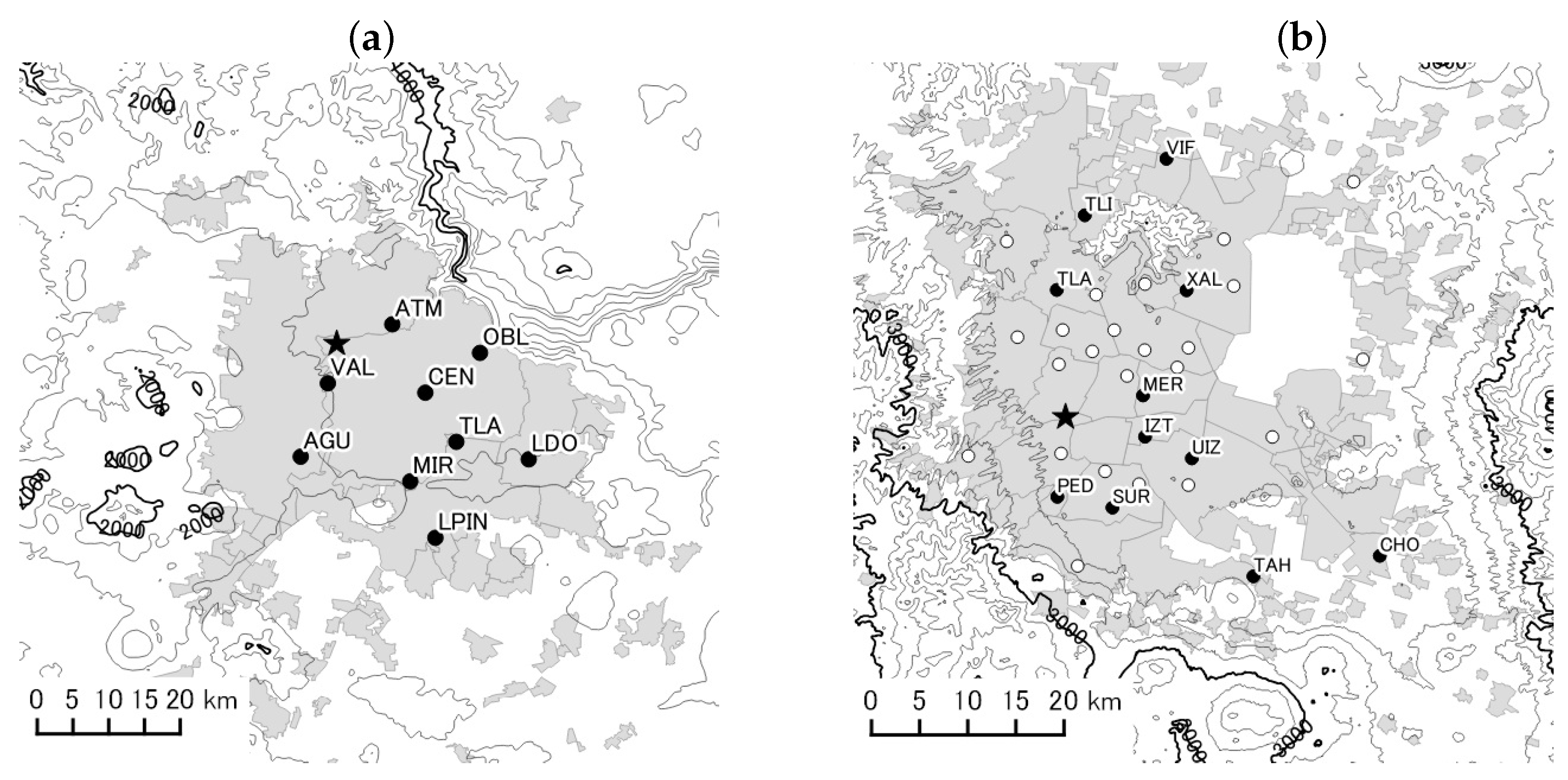
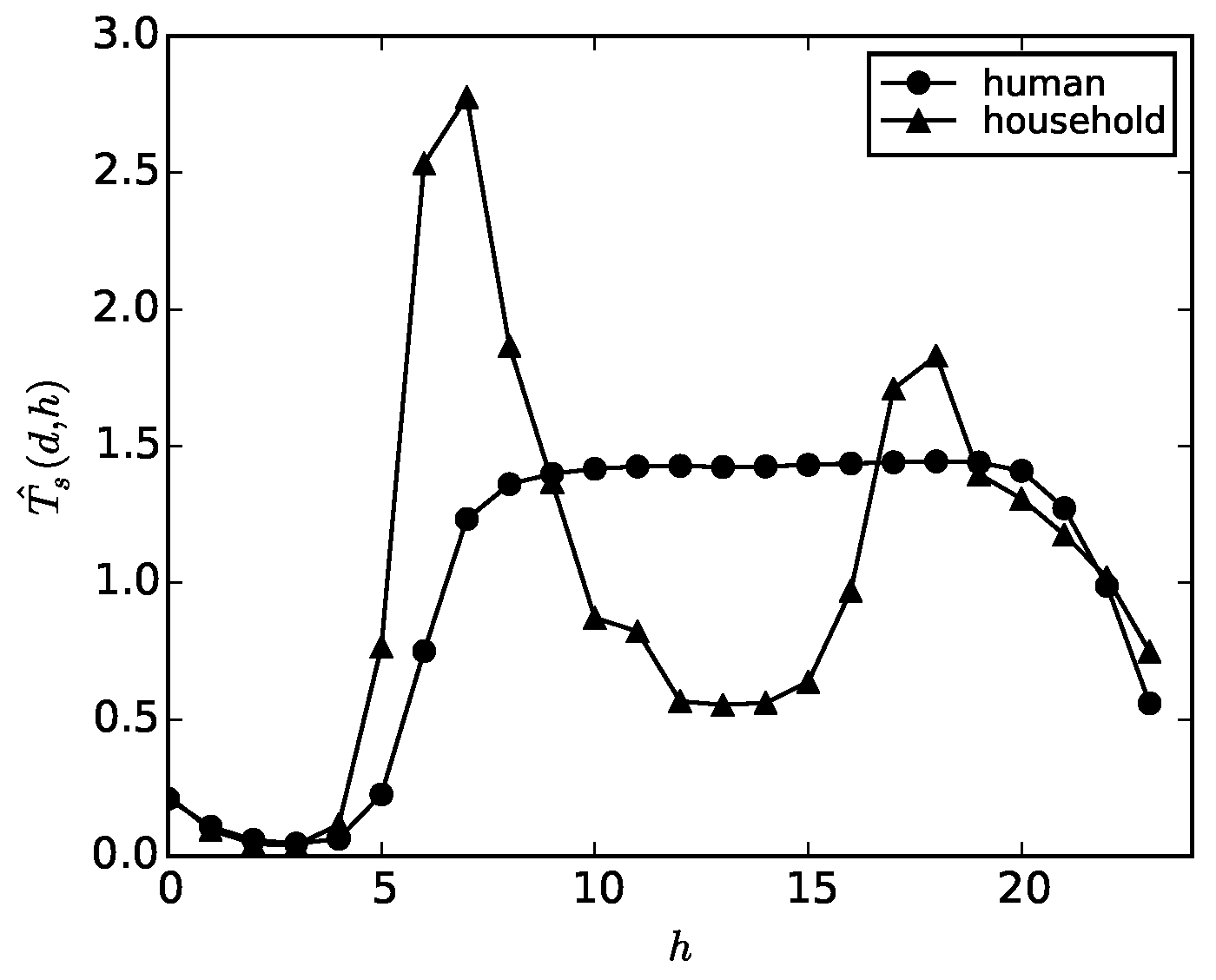
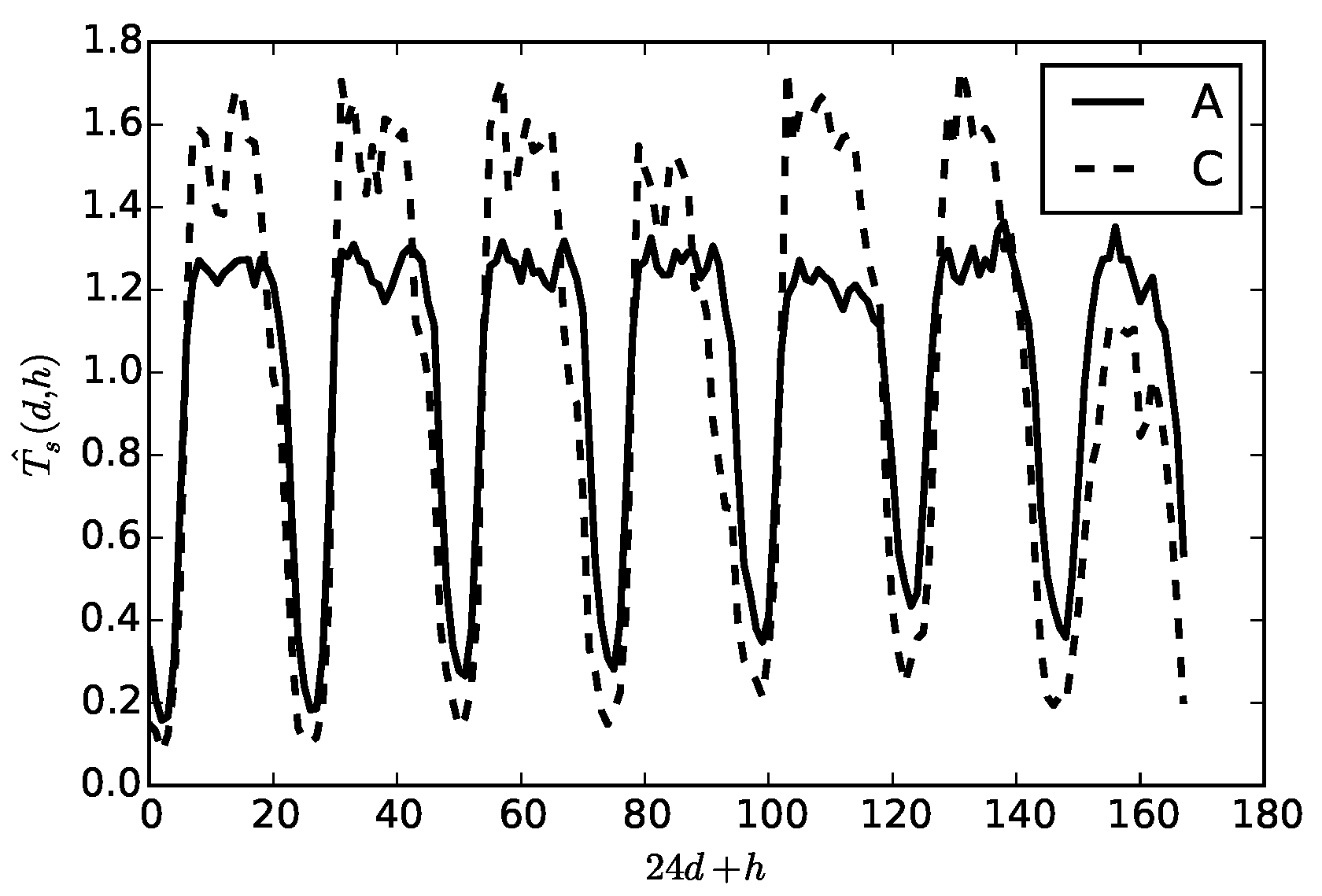
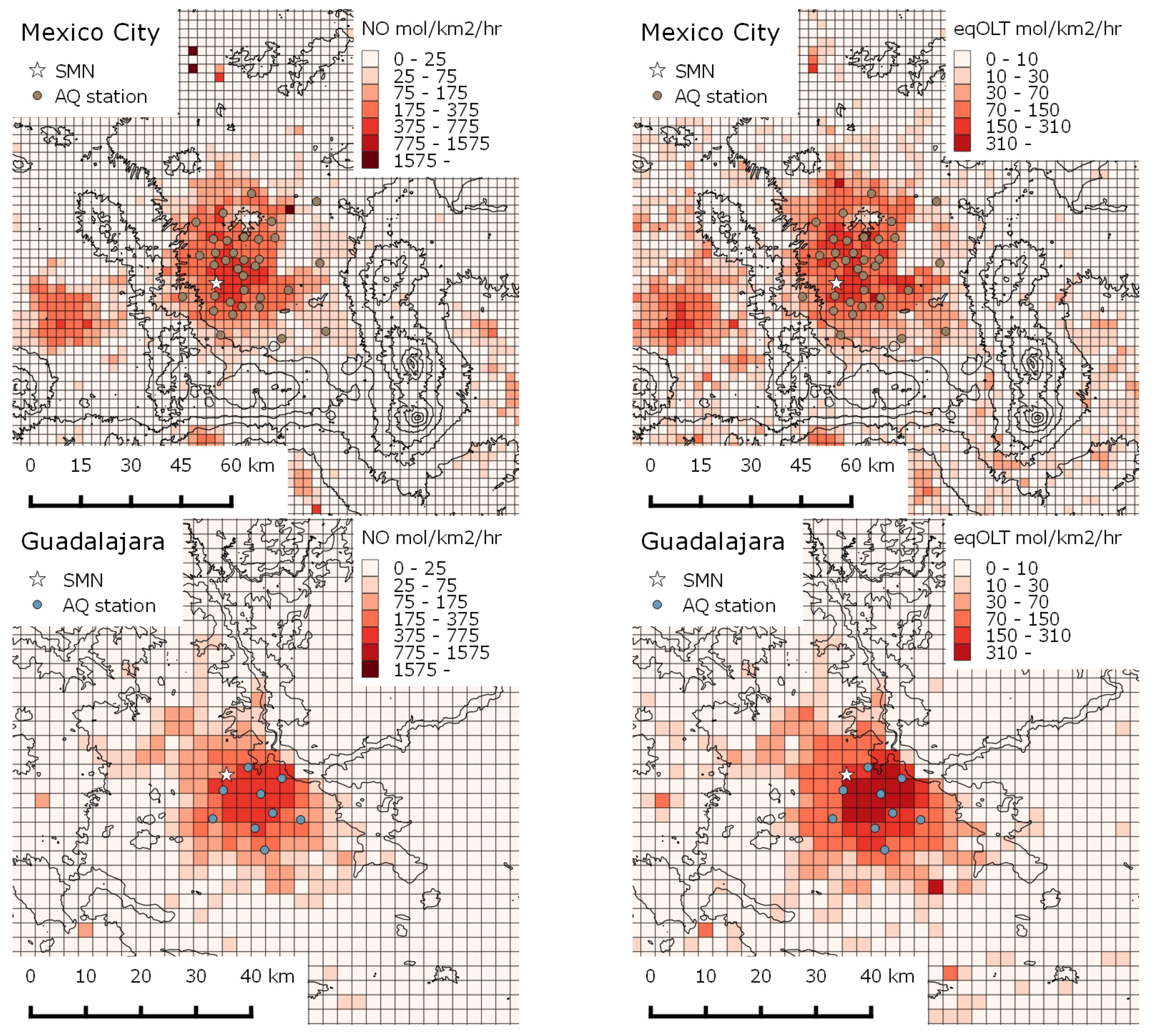
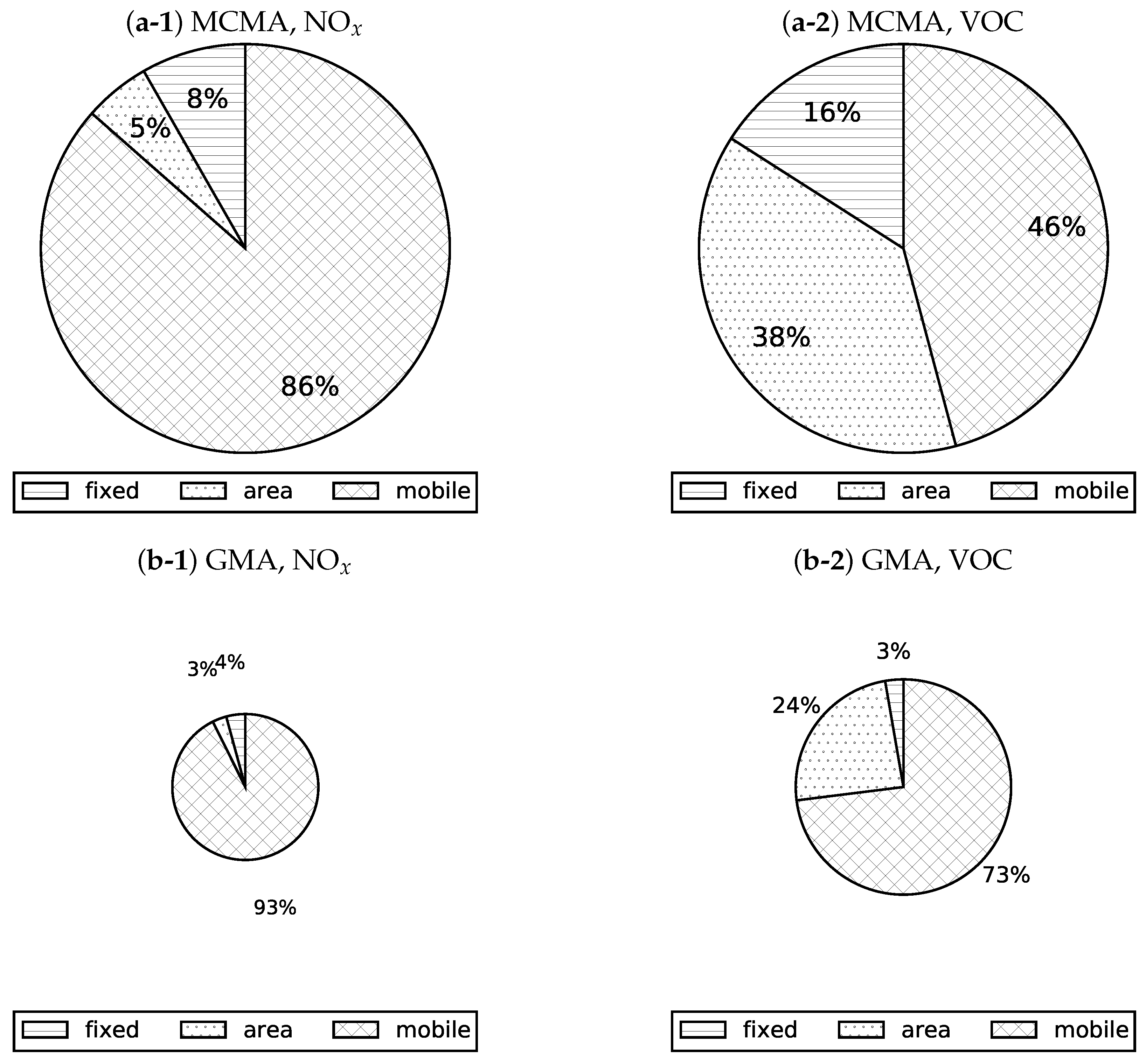
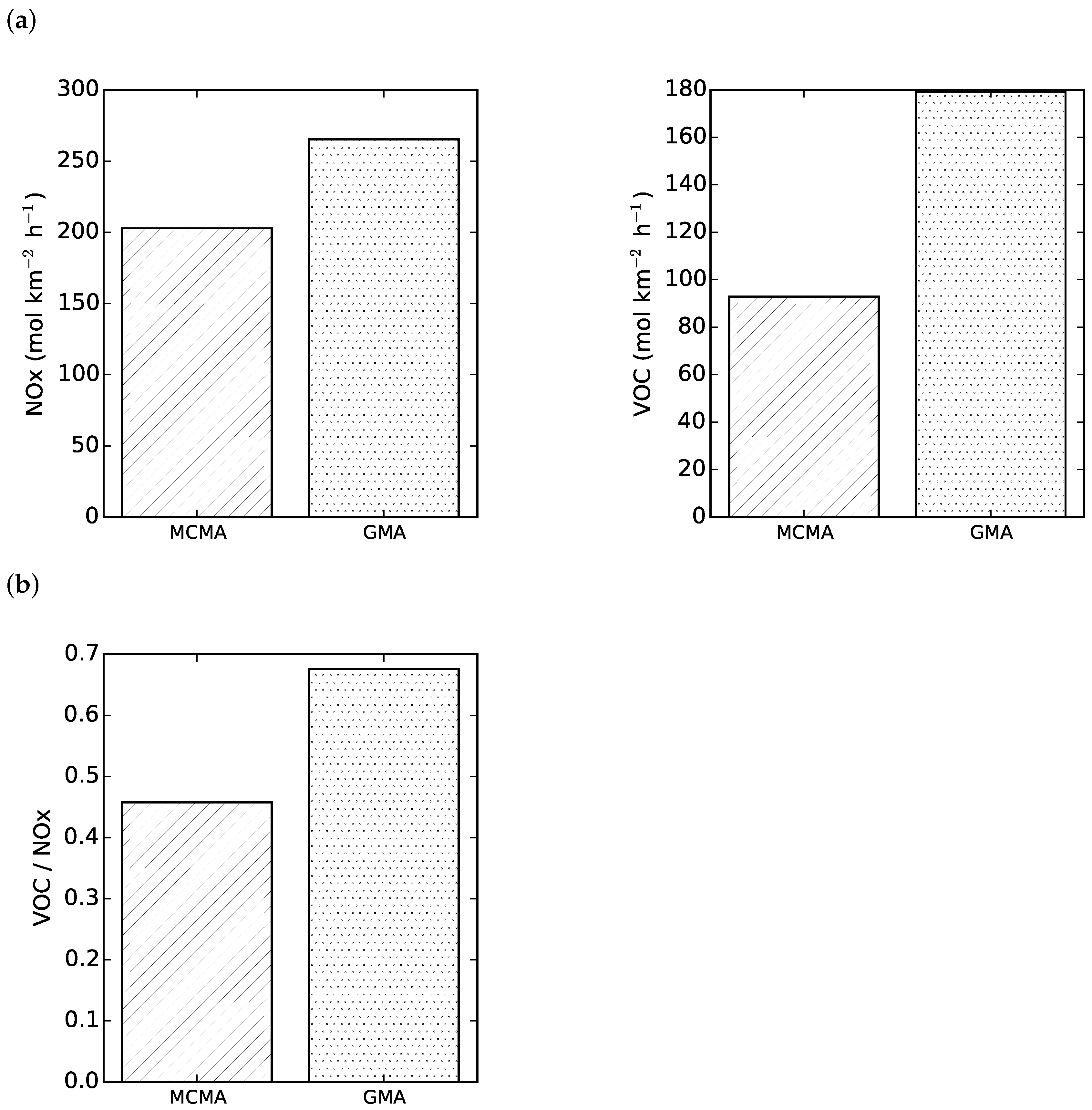
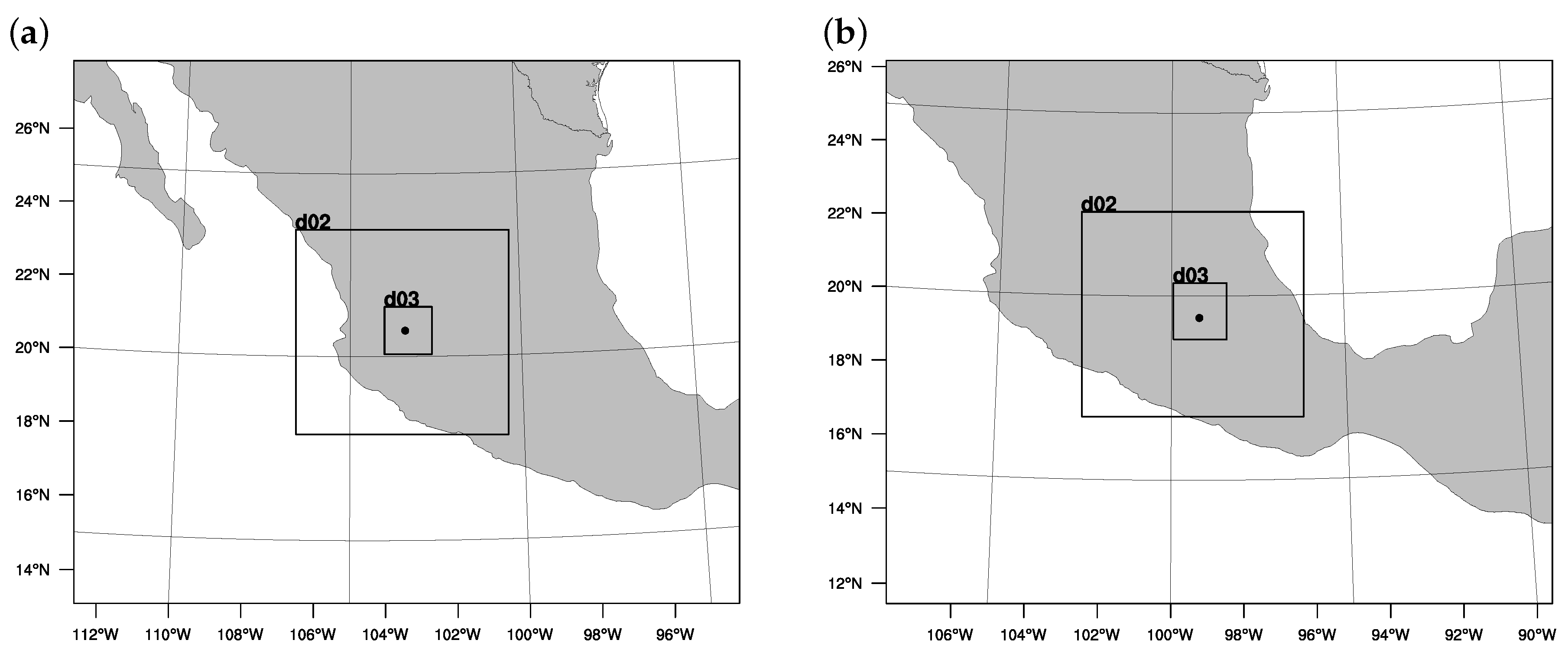
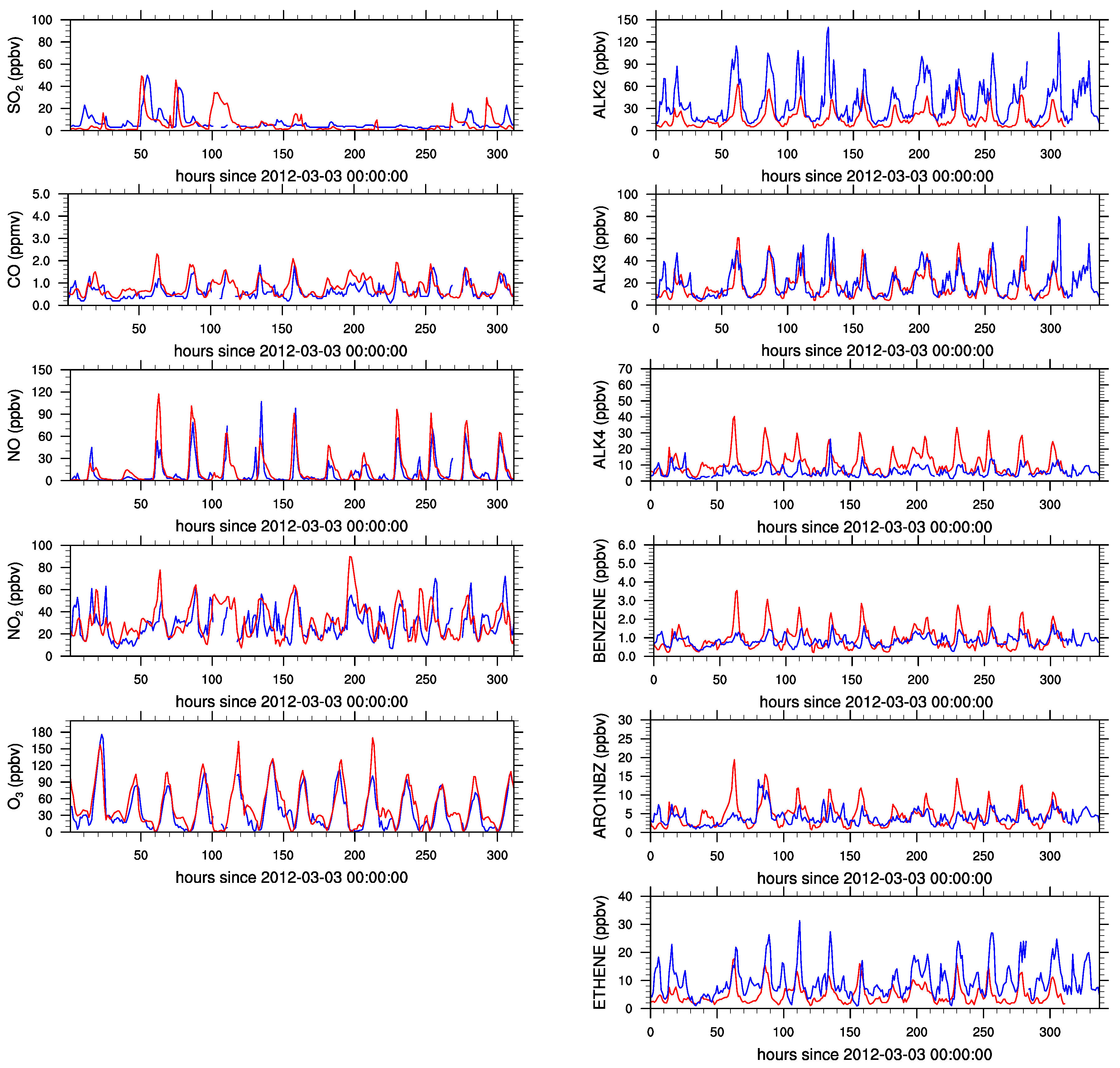
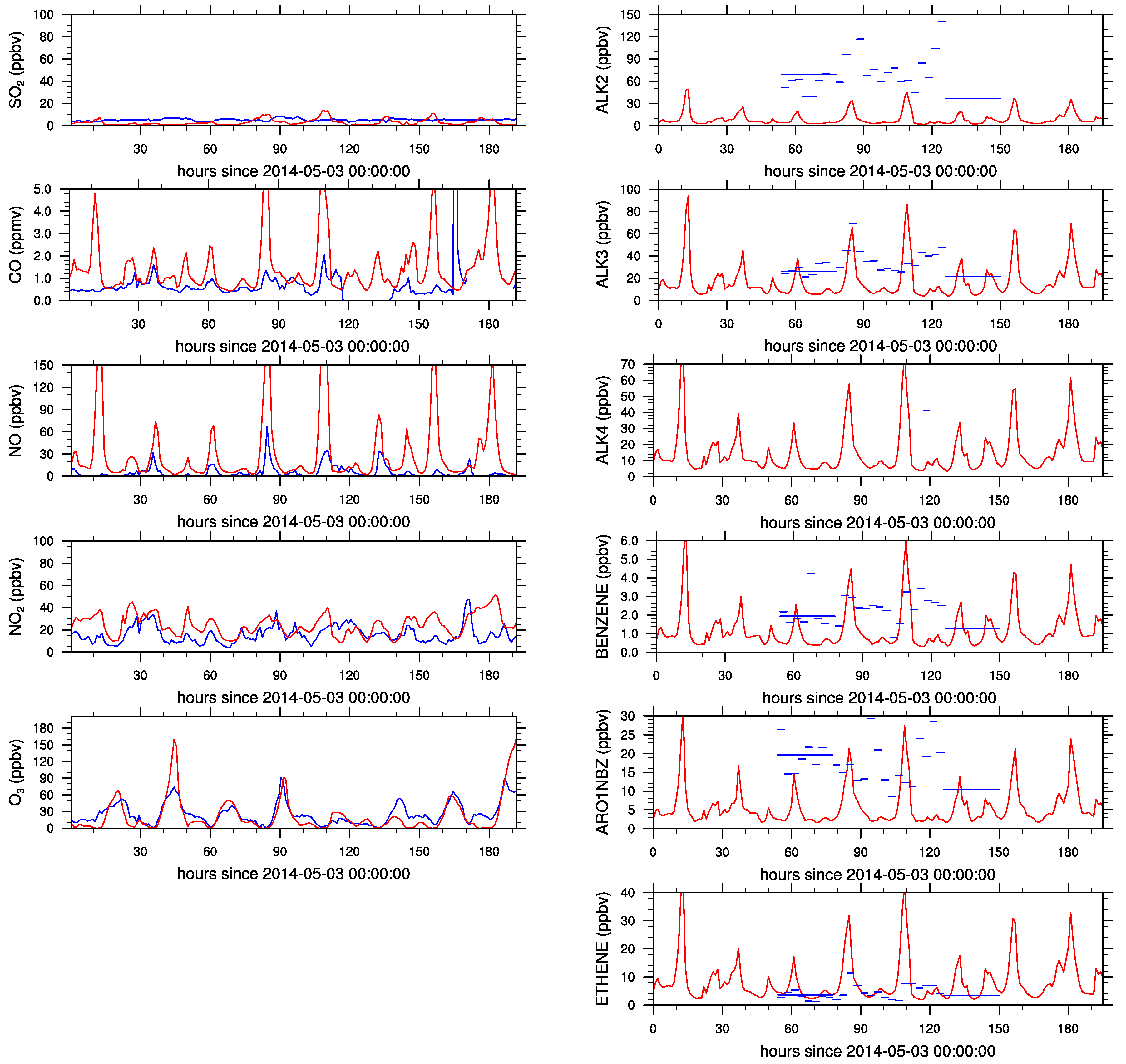
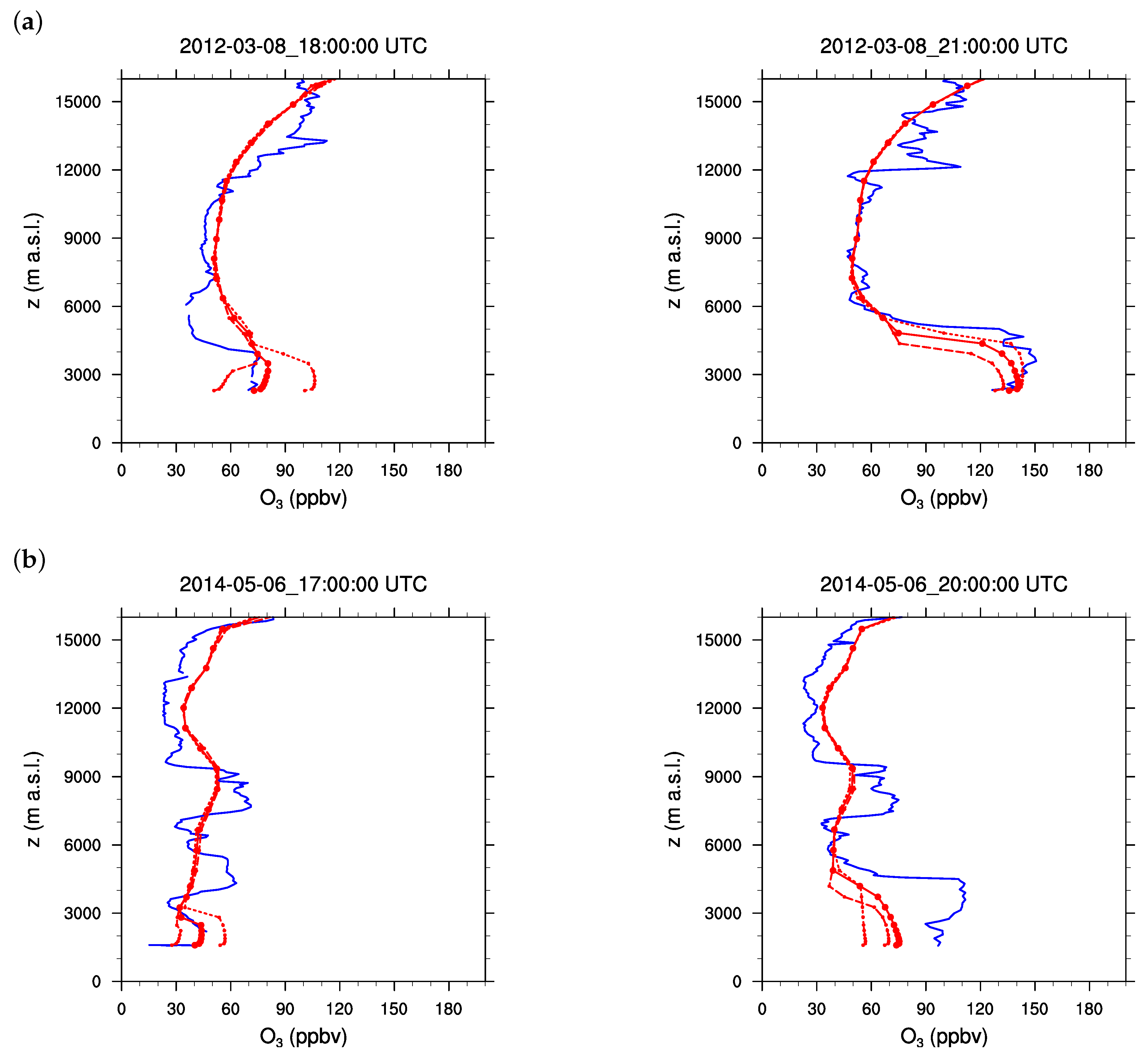
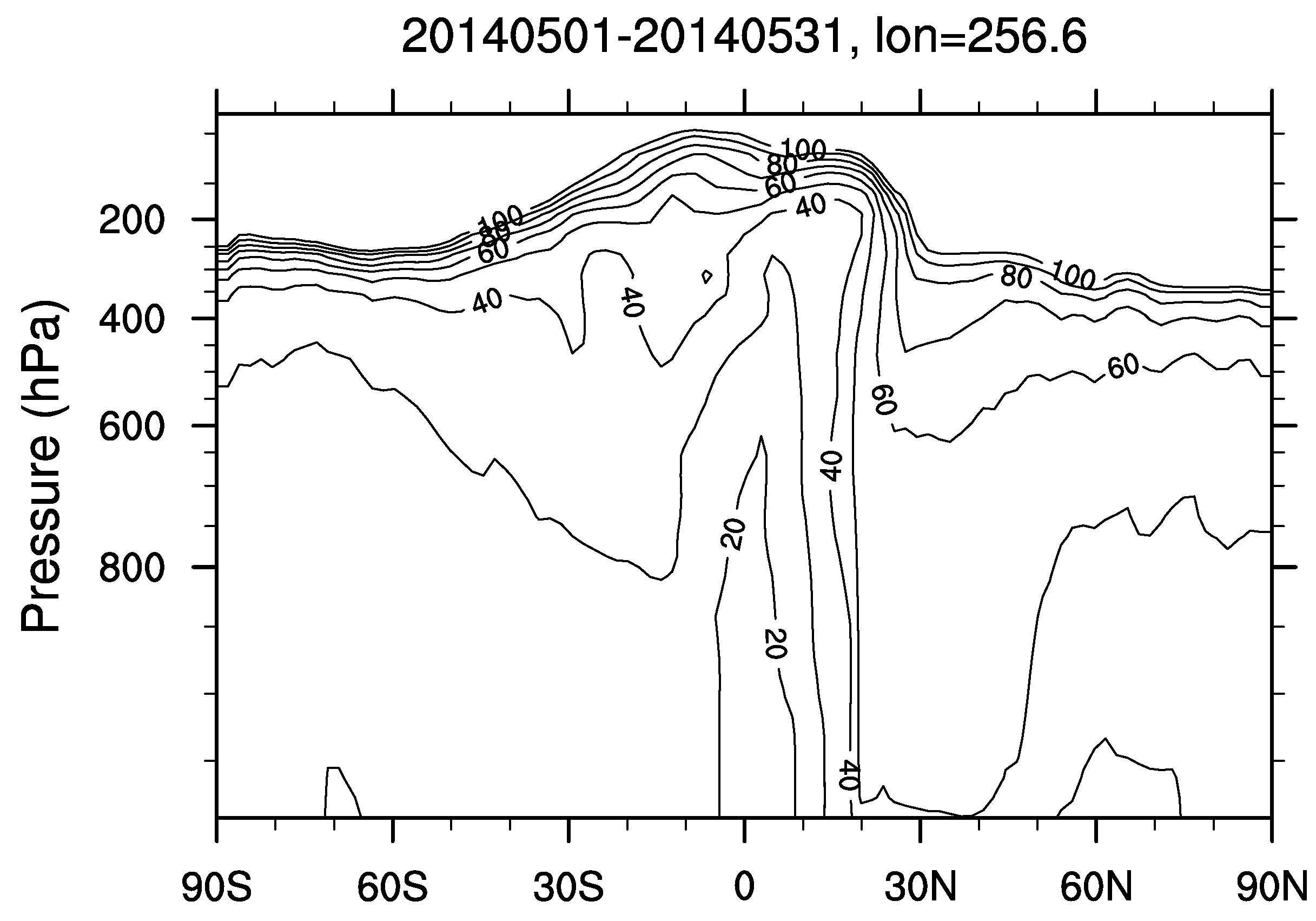
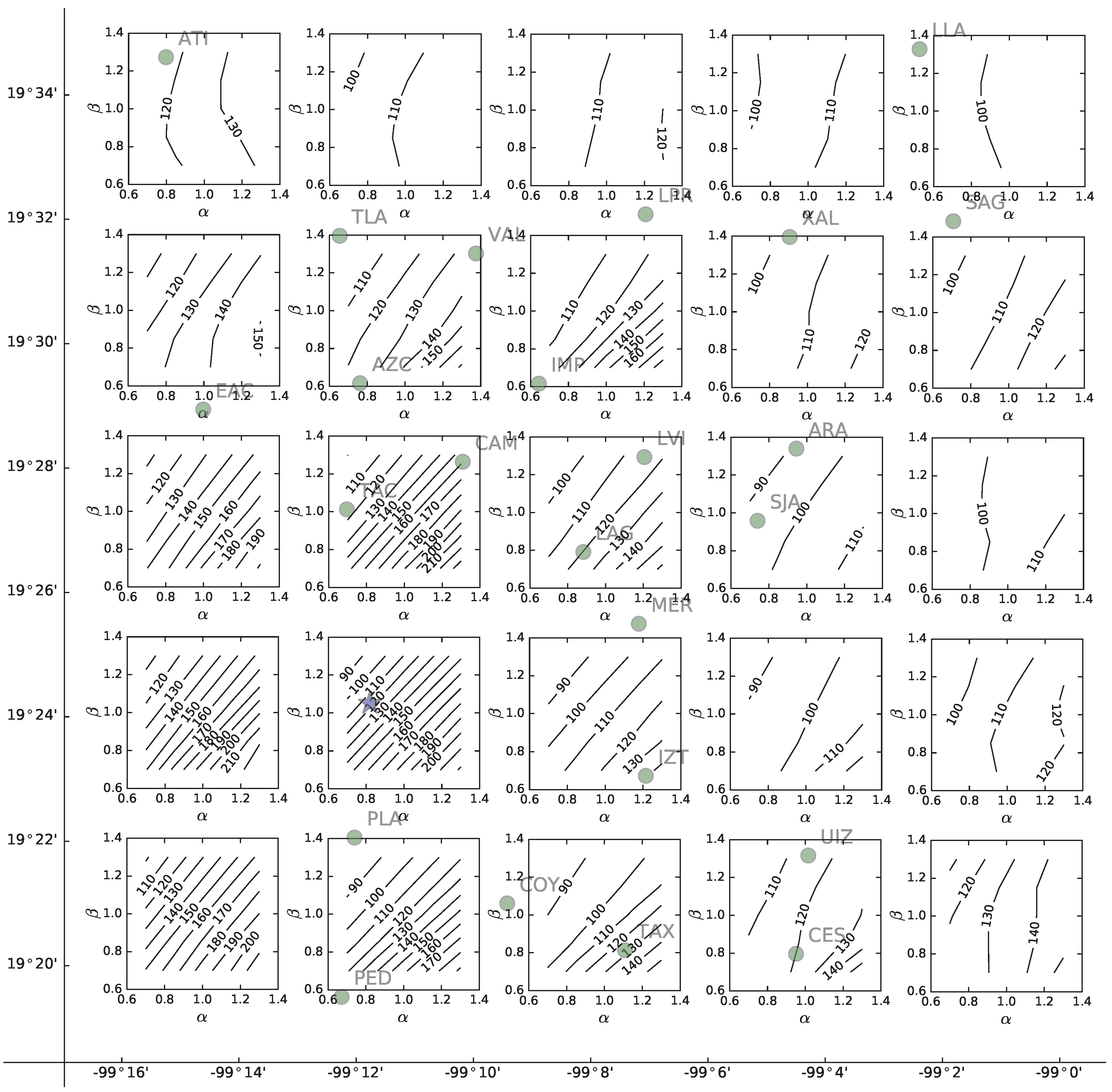
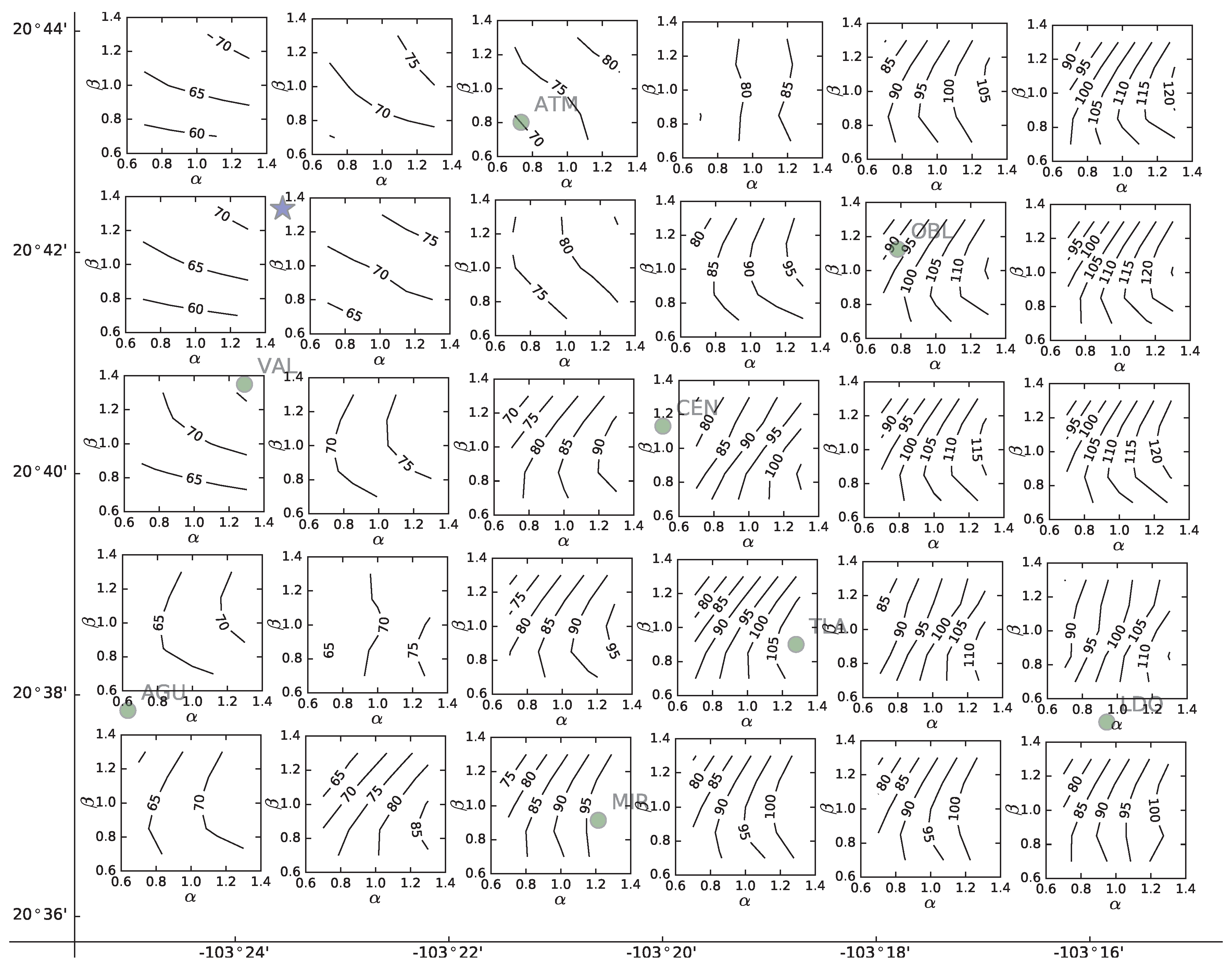
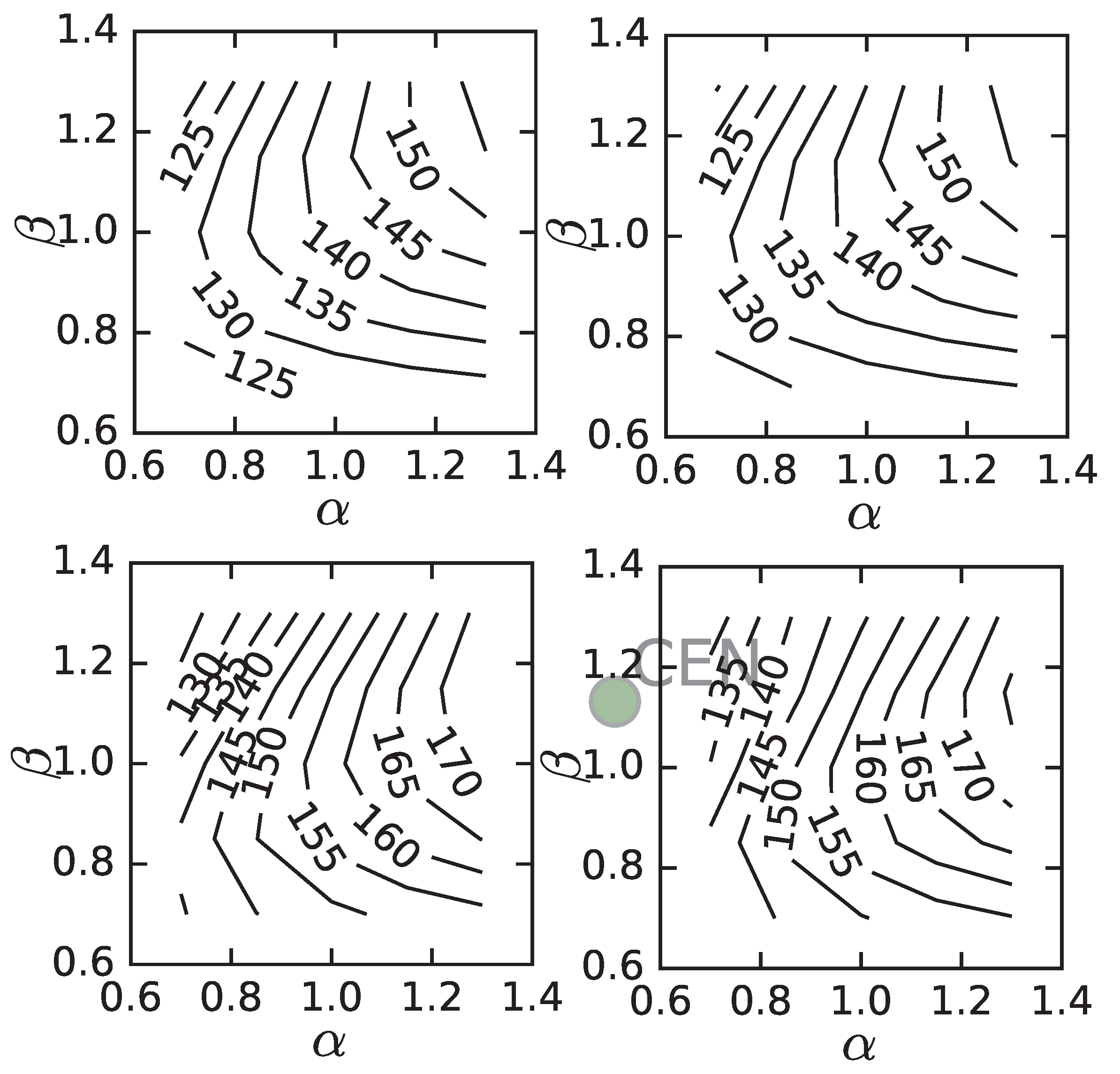
| Nesting | triple (d01, d02, and d03 from coarser to finer domain) |
| Grid Size | 27 – 9 – 3 km |
| Vertical Layers | 31 layers up to 50 hPa |
| Shortwave Radiation | Goddard scheme |
| Longwave Radiation | RRTM scheme |
| Microphysics | Lin et al. scheme |
| Planetary Boundary Layer | YSU scheme |
| Surface Layer | Revised MM5 Monin–Obukhov scheme |
| Landuse | unified Noah LSM |
| Urban Canopy Model | d03 only |
| Cumulus Clouds | Grell-3 scheme (d01, d02 only) |
| Boundary Condition | NCEP FNL (d01 only) |
| Grid Nudging | NCEP FNL (d01 only) |
| Chemical Mechanism | SAPRC99 |
| Radiation | table (off-line) |
| Emission | EDGAR v4.2 + MEGAN v2.10 (d01,d02) |
| INEM2008 + MEGAN v2.10 (d03) | |
| Boundary Condition | MOZART-4/GEOS-5 (d01) |
| Initial Condition | d01: Default profile |
| d02: End state of the first day of d01 | |
| d03: End state of the second day of d02 |
| FB | NMSE | IA | ||||||||||||||
|---|---|---|---|---|---|---|---|---|---|---|---|---|---|---|---|---|
| Region | Station (Abbreviation) | O3 | CO | NO | NO2 | SO2 | O3 | CO | NO | NO2 | SO2 | O3 | CO | NO | NO2 | SO2 |
| MCMA | Chalco (CHO) | −0.54 | 0.75 | 1.58 | 0.32 | −0.46 | 0.50 | 1.20 | 27.33 | 0.74 | 5.17 | 0.80 | 0.48 | 0.41 | 0.58 | 0.24 |
| Iztacalco (IZT) | −0.12 | −0.55 | −0.57 | −0.21 | −0.35 | 0.25 | 0.69 | 2.35 | 0.21 | 4.88 | 0.95 | 0.75 | 0.81 | 0.71 | 0.38 | |
| Merced (MER) | −0.06 | −0.40 | −0.47 | −0.19 | −0.14 | 0.20 | 0.60 | 2.33 | 0.19 | 3.43 | 0.96 | 0.76 | 0.81 | 0.73 | 0.41 | |
| Pedregal (PED) | −0.21 | −0.26 | −0.24 | −0.11 | 0.21 | 0.21 | 0.26 | 1.30 | 0.25 | 2.19 | 0.93 | 0.75 | 0.87 | 0.66 | 0.55 | |
| San Agustin (SAG) | – | – | – | – | – | – | – | – | – | – | – | – | – | – | – | |
| Santa Ursula (SUR) | −0.18 | 0.20 | −0.29 | −0.06 | −0.25 | 0.20 | 0.27 | 1.74 | 0.17 | 4.12 | 0.94 | 0.77 | 0.84 | 0.70 | 0.42 | |
| Tlahuac (TAH) | −0.56 | – | 0.54 | 0.21 | −0.85 | 0.50 | – | 6.39 | 0.38 | 7.52 | 0.79 | – | 0.60 | 0.70 | 0.26 | |
| Tlalnepantla (TLA) | −0.39 | −0.53 | 0.31 | 0.10 | 0.35 | 0.41 | 0.92 | 0.87 | 0.21 | 3.79 | 0.88 | 0.71 | 0.91 | 0.75 | 0.37 | |
| Tultitlan (TLI) | −0.35 | −0.37 | 0.26 | −0.08 | 0.07 | 0.33 | 0.56 | 1.57 | 0.23 | 7.33 | 0.89 | 0.79 | 0.88 | 0.83 | 0.28 | |
| UAM Iztapalapa (UIZ) | −0.15 | 0.02 | −0.16 | −0.22 | −0.26 | 0.19 | 0.21 | 0.87 | 0.21 | 2.01 | 0.95 | 0.86 | 0.91 | 0.76 | 0.55 | |
| Villa de las Flores (VIF) | −0.32 | −0.12 | 0.15 | 0.08 | −0.57 | 0.19 | 0.33 | 2.68 | 0.37 | 10.67 | 0.90 | 0.84 | 0.82 | 0.79 | 0.21 | |
| Xalostoc (XAL) | −0.26 | −0.26 | 0.68 | 0.16 | −0.06 | 0.22 | 0.33 | 2.13 | 0.22 | 2.72 | 0.92 | 0.90 | 0.81 | 0.79 | 0.62 | |
| GMA | Las Aguilas (AGU) | −0.24 | −0.70 | −0.58 | 0.02 | 0.80 | 0.61 | 3.52 | 11.37 | 0.81 | 1.66 | 0.78 | 0.18 | 0.18 | 0.44 | 0.50 |
| Atemajac (ATM) | – | – | – | – | – | – | – | – | – | – | – | – | – | – | – | |
| Centro (CEN) | 0.09 | – | −1.32 | −0.39 | 0.51 | 0.70 | – | 12.04 | 0.43 | 0.90 | 0.84 | – | 0.34 | 0.50 | 0.18 | |
| Loma Dorada (LDO) | −0.63 | −0.40 | −0.48 | 0.00 | 0.14 | 1.81 | 1.42 | 6.59 | 0.40 | 1.53 | 0.64 | 0.26 | 0.39 | 0.60 | 0.22 | |
| Las Pintas (LPIN) | – | −0.72 | – | – | – | – | 2.78 | – | – | – | – | 0.39 | – | – | – | |
| Miravalle (MIR) | −0.35 | −0.64 | −0.76 | 0.01 | 0.42 | 1.18 | 2.69 | 9.32 | 0.62 | 1.05 | 0.70 | 0.24 | 0.37 | 0.52 | 0.24 | |
| Oblatos (OBL) | −0.12 | −0.70 | −0.64 | −0.30 | – | 1.95 | 4.25 | 10.50 | 0.56 | – | 0.65 | 0.14 | 0.18 | 0.43 | – | |
| Tlaquepaque (TLA) | −0.10 | −1.01 | −0.96 | −0.12 | −0.34 | 0.92 | 3.92 | 8.57 | 0.32 | 1.80 | 0.79 | 0.15 | 0.31 | 0.59 | 0.26 | |
| Vallarta (VAL) | −0.27 | – | – | – | – | 0.68 | – | – | – | – | 0.79 | – | – | – | – | |
© 2016 by the authors; licensee MDPI, Basel, Switzerland. This article is an open access article distributed under the terms and conditions of the Creative Commons Attribution (CC-BY) license (http://creativecommons.org/licenses/by/4.0/).
Share and Cite
Kanda, I.; Basaldud, R.; Magaña, M.; Retama, A.; Kubo, R.; Wakamatsu, S. Comparison of Ozone Production Regimes between Two Mexican Cities: Guadalajara and Mexico City. Atmosphere 2016, 7, 91. https://doi.org/10.3390/atmos7070091
Kanda I, Basaldud R, Magaña M, Retama A, Kubo R, Wakamatsu S. Comparison of Ozone Production Regimes between Two Mexican Cities: Guadalajara and Mexico City. Atmosphere. 2016; 7(7):91. https://doi.org/10.3390/atmos7070091
Chicago/Turabian StyleKanda, Isao, Roberto Basaldud, Miguel Magaña, Armando Retama, Ryushi Kubo, and Shinji Wakamatsu. 2016. "Comparison of Ozone Production Regimes between Two Mexican Cities: Guadalajara and Mexico City" Atmosphere 7, no. 7: 91. https://doi.org/10.3390/atmos7070091





